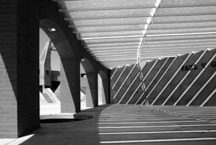
Nelson Fine arts Center. |
AP: In some ancient teachings, there is the implication that we have a kind of ‘soul amnesia’ with our life challenge becoming that of finding our way back again. ‘Ontological blindness’ may be a parallel to this that causes a prioritisation of technology over content. The last exposure I had to Peter Eisenman talking about that sort of thing was at a conference, where he was talking about weak form, Gianni Vattimo’s notion of weak form; the idea that little is given to us anymore in an unmediated form. Through all of the technological networks that pervade our lives, we’re getting the instant replay on the scoreboard rather than the double play that just happened before our eyes in the stadium. But I think that there are acts that derive from the crackling energies of our time coming through our bodies and our minds in an unformulated way; true unmediated acts and events land on the table in front of us. In my case – it’s hard to talk about – we’re animals that have been subjected to the conditioning that you describe when you talk about ontological blindness. I know, however, I’m connected to original events. There are no instant replays of the sunsets in New Mexico. I’m not in any way trying to say that we attain innocence by living out there. It’s the same old thing out here, it’s the same old American city in all its weirdness and glory as any other one, as in New York or LA. It’s just that in Albuquerque, it’s a wonderfully provincial version of things.
GHB: I think you’ve hit on something here. I was thinking
before we started talking today, about your being an American architect
essentially and especially belonging to a particular part of America.
You don’t belong totally to the Pacific – you lean that way
– you certainly don’t belong to the Atlantic side. But what
you’ve reminded me of is the great romantic attraction of the United
States to people from Great Britain, for instance, who come over here
and find an extraordinary sense of liberation in the vastness of the place,
and are surprised by the very high levels of efficiency in certain areas
compared to what we have in the UK. All this is combined with glorious
natural phenomena. These phenomena are celebrated through the medium you’ve
described and always were through the medium of the automobile. The great
love affair with the automobile and with all the gadgets and the technology
is what makes this place so extraordinary. The contrast to me, however,
is more remarkable when you get to this part of the States where you’re
in really a very primitive, ancient landscape. Yet you have the technology
to enjoy it and the contrast is very powerful, so I’m very much
in tune with what you’ve been saying.
AP: All this has to be carefully positioned. That sort of understanding of the relationship of technology to this place has to be conditioned by the admission that we’re really interlopers. Being an ‘American’ carries that burden. No one discovered this place, it was here already. Christopher Columbus didn’t discover anything, it was here, and we’ve come along as ‘latter-day discoverers’. But what are we discovering? The original cultures never had a sense of discovery about the place except moment-by-moment; they remained connected to its spirit.
GHB: If one looks for a couple of archetypes from the
not too distant past that seem to be synthesised in your work, among many
that I could mention are the Kaufmann Desert House by Richard Neutra and
Taliesin West by Frank Lloyd Wright. Neutra brought certain things to
the desert: the visual liberation of glass planes and all the wonderful
amenities that we associate with America. They seem to be represented
iconically in that particular Kaufmann House. This is really what has
happened, there has been this infusion and your work is part of that.
Perhaps we could just talk about the Nelson Fine Arts Center at Tempe,
which is an important building. I was very conscious when I was there
of the rather soft walls of the traditional Pueblo structures in the region,
and one does sense there, even with the colour of the walls at Tempe and
the way the light falls on them that this has become very important. You’ve
created a processional route which reminds me almost of the routes to
Egyptian temples: you go along a palm-lined route and reach the water
garden and then you either ascend or descend leading on to a plaza at
the back. This again is a profound response both to the particular location
and the purpose of the building.